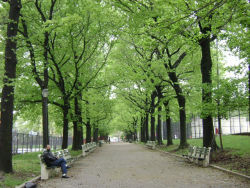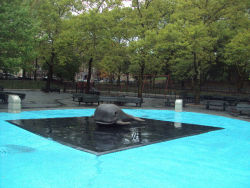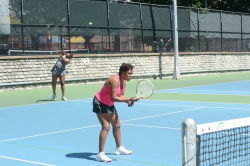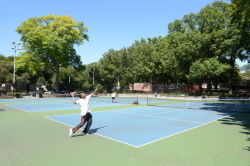Lincoln Terrace / Arthur S. Somers Park
Lincoln Terrace Park
This park is one of only two New York City parks named for our 16th president, Abraham Lincoln (1809-1865). Lincoln was born in a log cabin in Hardin County (now Larue County), Kentucky, and was mostly self-educated. He settled in New Salem, Illinois in 1831 and worked as a storekeeper, surveyor, and postmaster while studying law. In 1834 Lincoln was elected to the state legislature and in 1836 became a lawyer. Although he served in the House of Representatives as a Whig from 1847 to 1849, he lost two bids for the Senate in 1856 and 1858. Nonetheless Lincoln made an impression on his state and his nation over the course of his seven debates with Democratic opponent Stephen A. Douglas.
Lincoln successfully ran for president as a Republican in 1860. By his inauguration day in March 1861, seven southern states had seceded from the Union, and four more would follow in April. As the nation plunged into Civil War, Lincoln proved a skillful and thoughtful leader. In 1863 he issued the Emancipation Proclamation to free the slaves and delivered the Gettysburg address that eloquently memorialized fallen soldiers. He won re-election in 1864 against George B. McClellan. Five days after Confederate General Robert E. Lee's surrender on April 9, 1865, Lincoln was assassinated by John Wilkes Booth while attending a play at Ford's Theater in Washington, D.C. He died the next morning.
The City of Brooklyn purchased the first parcel for the 21-acre park between 1895 and 1897. The park was graded, planted with trees and shrubs, and enclosed with an iron fence. According to the 1918 Annual Report of the Brooklyn Department of Parks, anti-aircraft gun bases were installed in the park in "serviceable but inconspicuous locations" during World War I. Additional park parcels were acquired between 1916 and 1935. These included the northeast tip of the park, which had been acquired by the Department of Transportation as part of the IRT subway extension in 1916 and became parkland in 1928. The closing of President, Carroll, and Crown Streets between Rochester and Buffalo Avenues united the separate parts of the park.
Lincoln Terrace has long been a haven for the people of Brownsville and Crown Heights. Renowned authors Alfred Kazin and Elliott Willensky, who grew up nearby, remembered that the park was a favorite spot for hanging out and flirting. Yiddish-speaking residents knew it as "Kitzel Park" or "tickle park." In 1932 the Board of Aldermen named the west portion of the park for Arthur S. Somers (1866-1932), a local philanthropist and civic activist. Many of the park improvements, including tennis and handball courts, a playground and public restroom date to the 1930s.
The elegantly terraced tennis courts were reconstructed in 1996. The project provided new courts, retaining walls, fencing, benches, water fountains, security lighting, landscaping, and handicapped access. In addition to the courts, Lincoln Terrace offers wooded groves of gracious old trees, open lawns, two playgrounds, basketball and handball courts, a baseball field, and a public restroom.
Check out your park's Vital Signs
Clean & Safe
Green & Resilient
Empowered & Engaged Users
Share your feedback or learn more about how this park is part of a
Vital Park System




